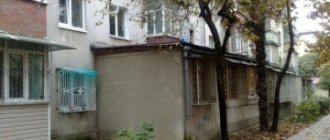Real estate transactions are individual, and therefore each of them has its own implementation scheme. Sometimes dividing the room into several parts can solve the problem. We will look at how to divide non-residential real estate into two parts in this article.
Various transactions with residential and non-residential real estate require a variety of legal support. Sometimes it is very difficult to manage shares in large premises. And in this case, the situation can be resolved exclusively through the official division of real estate into two parts.
Dear readers! Our articles talk about typical ways to resolve legal issues, but each case is unique. If you want to find out how to solve your specific problem, please contact the online consultant form on the right. It's fast and free! Or call us at 8(800)-350-30-02 (the call is free for all regions of Russia)!
What is the division of buildings and premises into new premises?
In the field of construction and real estate, only division into homogeneous objects is allowed. Therefore, it is impossible to divide the building into premises, due to their fundamentally different legal status. However, in fact, the building is divided into separate rooms during construction or during subsequent operation. This procedure consists of limiting certain areas with walls, partitions, ceilings, and other structural elements.
The building can also be divided into temporary parts, without any fencing at all. However, such temporary parts will not constitute real estate. Theoretically, the building can only be divided into new buildings, but in practice such work is impossible to carry out, or at significant expense.
The premises can be divided, and as a result of work and approvals, two or more new objects can be formed. The original premises will lose its existence as a real estate object and will be excluded from the Unified State Register of Real Estate with the cancellation of the cadastral number. The option of creating a new premises while preserving the original object is allowed only in the form of a division.
Regulatory acts
The basic rules for dividing real estate are specified in federal legislation. Depending on the type of work, the following will apply:
- GRK RF ();
- Housing complex of the Russian Federation ();
- Law No. 384-FZ ();
- Law No. 123-FZ ();
- Decree of the Government of the Russian Federation No. 87 ();
- Decree of the Government of the Russian Federation No. 468 ().
Coordination of reconstruction or redevelopment takes place at the local level. Therefore, Moscow Government Decrees No. 432-PP, 508-PP, 692-PP will additionally be applied. These governing documents contain not only approval regulations, but also a number of prohibitions on work (they mainly apply to premises in apartment buildings). Also, for design purposes, separate joint ventures, SNiPs and GOSTs will be selected for different types of buildings.
In simple terms
In order for a new property to be formed as a result of division, it must meet the criteria of isolation and isolation. This rule is specified in Law No. 218-FZ and will be checked during approvals, cadastral registration and registration of rights. Isolation consists in enclosing the area of the object from the rest of the building (for example, due to existing and newly erected walls). Separation is confirmed if the premises have a separate exit to the street or to common areas.
The division of buildings and premises can be carried out for the following purposes:
- for the formation of new objects with a similar purpose (for example, instead of one large apartment, you can make two small ones);
- for redistributing large areas into several small premises, renting them out or using them for other purposes;
- to differentiate rights between several owners, if determining the shares is not enough for this (for example, if each of the co-owners wants to receive their share in kind);
- for simultaneous change of purpose and repurposing of the building (for example, if you carry out redevelopment and turn large production areas into apartments).
If you just need to temporarily allocate space for different commercial purposes, you can divide it into parts without any construction work or additional approvals. For example, you can “cut” a large retail space into many small retail outlets according to lease agreements and technical plans. Such parts can be placed on temporary cadastral registration for the entire rental period.
Expert commentary. The hardest part is dividing living spaces. In such a situation, it is necessary not only to take into account building safety standards, but also to make separate exits for each newly formed apartment, comply with the requirements for the minimum living space of rooms, and cut new windows for natural light. In non-residential buildings and premises there are significantly fewer restrictions. In addition, for non-residential objects, decisions are made only by the copyright holders themselves, and when working in apartment buildings, approval from the general meeting is required.
One of the mandatory conditions of the division is compliance with the signs of isolation and isolation, the presence of a separate entrance to each room
Why is this procedure necessary?
The division of a non-residential property into several parts implies the implementation of this process at the legislative level, so that as a result, for each allocated part, you receive a certificate of ownership and a separate cadastral number. The need for such a section arises when the following transactions are to be made:
- purchase and sale;
- rent;
- sublease;
- conclusion of a mortgage agreement.
Important! When dividing, the number of parts does not matter. A non-residential property can be divided into as many parts as necessary.
Building codes and restrictions for division into premises
In addition to complying with the rule on dividing buildings and premises into similar objects, there are other restrictions. For example, having divided non-residential premises, you cannot automatically recognize them as apartments and use them for human habitation. To do this, it is necessary to confirm that the object meets the standards for housing (they are specified in the Decree of the State Construction Committee of the Russian Federation No. 2003 and other acts).
There are other restrictions that must be observed when working for the purpose of division:
- for newly formed residential premises, the minimum size of rooms cannot be less than 8 sq.m., and their width cannot be less than 2.25 m;
- it is impossible to make a division into full-fledged real estate objects if it is impossible to ensure their isolation and isolation (according to the criteria indicated above);
- during the division process, all newly created premises must comply with fire, sanitary, hygienic and other safety standards (for example, a division with a general reduction in living space by increasing other premises is impossible in violation of the “wet zones” rule or other standards);
- The section should not worsen the living conditions in other premises of the apartment building, or lead to damage or destruction of the structures of any building.
In most cases, it is impossible to make a division in kind according to the shares specified in the title documents. Also, the work requires the consent or agreement of the copyright holders, and in the MKD - the approval of the residents of the house.
Expert commentary. During design and work, general construction restrictions specified in federal and local regulations must be observed. For example, it is prohibited to dismantle or block ventilation ducts, public utility networks, emergency warning systems and escape routes. All these points will be taken into account by the designers of the Cadastral Moscow company if you choose us for the section.
The essence of dividing non-residential premises
Division of non-residential premises is the process of converting one property into two separate ones. The process is carried out with the participation of a cadastral engineer and with the approval of EGRN employees. Typically, the initiator of the division is the owner of the premises. But other options are also allowed. Example: an application is submitted by tenants who wish to divide the rented premises into two separate objects.
The division process is carried out both voluntarily and compulsorily.
Possible option: the property owner is obliged to transfer part of his property to creditors, by court decision. In this case, the premises are divided, and one of the parts goes to pay off the debt. The size of the separated share is determined by the judge, with the assistance of the cadastral engineer.
We advise you to read:
- ✅ How to register a lease agreement for non-residential premises?
- ✅ Assignment of the right to lease non-residential premises
- ✅ How to transfer a residential premises to a non-residential one?
- ✅ Certificate of acceptance and transfer of premises upon termination of the lease agreement: sample
What projects and work are needed to divide buildings and premises
The list of works during reconstruction and redevelopment differs significantly, which will entail different approval procedures. Redevelopment work may include:
- erection, transfer or dismantling of capital walls inside the original premises and along the perimeter;
- combining premises or parts thereof to include their area in a new facility;
- cutting a new exit to the street or to common areas, arranging an entrance group (porch, vestibule, ramps, stairs);
- arrangement, expansion, transfer or sealing of openings for windows;
- relocation of utility networks and plumbing equipment, including the division of their systems into all new premises (this work falls under reconstruction and can be combined with redevelopment);
- facade work associated with the emergence of new objects.
It is important that during the redevelopment the parameters of the entire building will not be changed, i.e. its area, height, number of storeys, and other basic characteristics will remain unchanged.
During reconstruction, on the contrary, the parameters of the building and all its premises may change. Therefore, for the section you can use the same types of work as for redevelopment, as well as:
- adding a new floor or adding an attic volume to newly created premises;
- replacement, restoration and installation of new load-bearing structures (this is especially true for creating walls near newly formed premises);
- extension of an additional part of the building (as a result of such work, additional area can be cut for each new room);
- other types of work in premises and buildings.
As with redevelopment, the reconstruction section should be thoroughly described in the project. For this purpose, architectural, engineering, planning and other solutions are selected and described, calculations of loads and reinforcements are made, structures and materials with the appropriate characteristics are selected.
For the division of buildings and premises, it is always necessary to develop and approve a project
Formation of a part or division when renting - what to choose
Renting out an entire large space or building can be more difficult than renting out many smaller locations. For example, for entrepreneurs, a few square meters in a shopping center area may be enough to place equipment and start working, rather than renting a separate isolated room. In such cases, forming part of a room or building may be the best option, since there will be no need to carry out construction work.
Here are the main features of the temporary formation of parts of premises and buildings:
- there are no restrictions on the formation of part of the room in several places over a large area at once;
- it is not necessary to install walls and partitions, or temporary enclosing structures can be erected;
- the part of the non-residential building or premises to be leased is determined by the contract, after which a technical plan must be ordered for it;
- Based on the technical plan, temporary registration will be carried out in Rosreestr.
The formation of part of the premises with temporary registration is an official and legal procedure provided for by Law No. 218-FZ. Therefore, an extract from the Unified State Register will be issued for the educated part. After the expiration of the lease period, the USRN information about the temporary part of the object will be canceled. You can learn about the nuances of allocating part of the room from our experts.
Parts of premises and buildings are usually allocated for rent to small businesses
Step-by-step instructions for dividing a building or premises
Reconstruction and redevelopment are characterized by different approval procedures. If there is enough redevelopment work for the section, i.e. Only the parameters of the premises will change; approval requires:
- conclusion of an agreement between copyright holders, or execution of their written consent to the division;
- obtaining approval through a MKD meeting (this is not required for non-residential buildings);
- project development, obtaining a technical report on the condition of structures (for small apartment buildings);
- submission of documents to the Moscow Housing Institute (this department in Moscow issues approvals for redevelopment work);
- contacting MosKomArchitecture (if changes to the facades are allowed during the division);
- carrying out work strictly according to the project, in compliance with safety standards;
- contacting the Ministry of Housing for inspection after work, signing a commission act.
Next, you need to record that as a result of the division, new real estate objects appeared. For this purpose, technical plans are ordered for each newly created premises. To undergo cadastral registration and enter new data into the Unified State Register of Real Estate, a technical plan with other documents is submitted to Rosreestr. After completing the procedures, information about the newly formed objects, including their new cadastral numbers, will appear in the Unified State Register of Real Estate. At the same time, registration of rights is carried out if this is provided for in the agreement of the owners.
When dividing through reconstruction, the approval procedure will go through the following stages:
- design and working documentation is developed, and its examination is carried out (in the capital, this procedure can be completed through the Moscow State Expertise);
- documents are submitted to Gosstroynadzor to obtain a construction permit;
- Notifications of the commencement and completion of work at the site are submitted to the above department;
- After the reconstruction is completed, you need to contact Gosstroynadzor again and obtain permission to put it into operation.
The remaining formalities for partition through reconstruction will correspond to the redevelopment approvals. It is necessary to conclude agreements between the owners or obtain their consent; it is necessary to order a technical plan for each new premises. After completion of cadastral registration and registration of rights, an extract from the Unified State Register will be issued.
Expert commentary. It is unacceptable to begin work on this section without completing the project and permits. This not only poses a threat to the safety of the building, but also practically makes it impossible to legitimize redevelopment and reconstruction. To avoid any difficulties, order design and approval services from the Cadastral Moscow company.
In this example, two new objects were created from one non-residential premises
Grounds for separation
There are only two grounds for dividing non-residential premises: a voluntary decision of the owner (owners) and a court order.
The owner's consent is drawn up in writing by a notary. If there are two or more owners, written confirmation of the consent of each of them is required.
By court decision, division is carried out if the owner refuses to carry out this procedure, although he is obliged to do it. Example: non-residential premises are part of the inheritance and must be divided among the heirs. But there is no will, and the heirs have disagreements. In such a situation, the division of non-residential premises is carried out by court decision.
Where do you need to agree on the division of buildings and premises into new premises?
To coordinate the division of buildings and premises, you need to contact the following services:
- MZHI - for redevelopment;
- MosKomArchitecture - for redevelopment and reconstruction if the facades are changed;
- Gosstroynadzor - if the division is carried out through reconstruction;
- BTI - to make changes to the technical passport of the building;
- Ministry of Emergency Situations, SES (Rospotrebnadzor) - these departments check the project for compliance with safety standards, participate in inspections of newly formed premises;
- Rosreestr - carries out cadastral registration and re-registration of rights.
Only a reconstruction project should be submitted for examination. Additional permits will be required if the building is classified as a cultural heritage site.
In this case, when dividing the premises, isolation and separation were not achieved. therefore, part of the property can be rented out and placed on temporary cadastral registration
What to do if the section is refused
If the owner has received a refusal to carry out work to modify the premises, he should familiarize himself with the received paper. It describes the detailed reason for the negative decision, indicating any deficiencies. It is necessary to try to eliminate existing shortcomings and contact the chamber again. The period for reviewing documentation is ten days. If the papers are sent electronically, the period increases to eighteen days.
Important! If the refusal is for an unclear reason, the owner is sure that there are no grounds for making a negative decision, you can go to court.
At any stage, the owner of the premises may encounter disagreement from the authorities. In this case, it will not be possible to resolve the issue without the participation of the court.
Remember! You don't always need to go to court. It is quite possible that you will be able to come to an agreement with government officials.
What documents are needed to approve the division?
To successfully complete the division procedure and achieve positive approvals, you will need:
- title documents for the building and (or) premises;
- agreement between the owners, or written consent from all copyright holders of the object;
- minutes of the MKD meeting with approval of the work;
- redevelopment or reconstruction project, technical report (for apartment buildings);
- expert opinion;
- application to the Moscow Housing Institute for approval;
- construction and commissioning permits;
- BTI registration certificate;
- acceptance committee report;
- cadastral engineer's technical plan.
Our specialists will prepare all the necessary forms and forms according to. Contact us, we have the most favorable conditions!
How to behave in case of refusal?
When conducting a legal examination, based on the documents provided, Rosreestr may decide to register and register ownership of the property of interest, and may also suspend or refuse to complete this procedure.
If the applicant is refused registration, the document must detail the reasons for this decision. It is necessary to contact a cadastral engineer, who must correct all the indicated shortcomings and errors and then independently send the corrected documents to the necessary authorities.
As a result, we can conclude that the division of non-residential real estate is certainly a long and difficult process. You need to be patient and comply with all legal requirements, take into account all the nuances.
It is best to try to agree with the remaining co-owners to make a division by mutual consent. If you go to court, the procedure may be delayed, and the financial costs will be higher.
Real estate transactions are individual, and therefore each of them has its own implementation scheme. Sometimes dividing the room into several parts can solve the problem. We will look at how to divide non-residential real estate into two parts in this article.
Various transactions with residential and non-residential real estate require a variety of legal support. Sometimes it is very difficult to manage shares in large premises. And in this case, the situation can be resolved exclusively through the official division of real estate into two parts.
How to correctly draw up technical specifications for the section of buildings and premises
Drawing up technical specifications is no less important stage than design or construction work. Inaccurate or incorrect terms of reference will entail repeated redoing of the project, indication of an incomplete list of works, and difficulties with approvals. Specialists of the Cadastral Moscow company will provide services for filling out technical specifications for any division options. An example of a technical specification can be found below.
[su_document url=”https://xn—-8sbnaobhgmnivvj0c8a.xn--80adxhks/wp-content/uploads/2020/03/TZ-na-razdel-pomeshhenij.doc”]
How to arrange the formation of premises
The creation of new premises within the boundaries of the building occurs by decision of the owner. Accordingly, if non-residential premises are divided into several new objects, such a decision must be expressed by all owners on the right of shared ownership.
The results of construction work, after drawing up the act, must be recorded in the technical plan. To do this, the owner of the object performs the following actions:
The information in the article contains general information, but each case is unique:
- after signing the act, you need to apply for the preparation of a technical plan of the building, as well as each changed or created non-residential premises;
- the engineer carries out cadastral work - requests USRN information and archival documentation of the BTI (technical passport of the building and premises, floor plans, etc.) - if necessary, conducts an actual survey of the property;
- as a result of the inspection, the engineer establishes the following parameters - the area and location of each room within the building, the presence of enclosing elements and structures, door and window openings, etc.;
- if a building is registered for the first time with the simultaneous formation of premises, it is necessary to carry out cadastral work on the land plot - surveying will allow determining the location of the building on the site and its coordinates;
- The engineer records the results of cadastral work in the technical plan - a text description of the characteristics is filled in, the resulting premises are reflected on the floor plan of the building, diagrams and drawings are drawn up.
The technical plan is the basis for applying to Rosreestr - registration occurs at the request of the owner or the parties to the lease agreement. The formation of a premises, division or allotment will be considered completed from the moment the cadastral registration information is entered into the Unified State Register. For each independent property, the owner will receive an extract from the register.
Expert commentary . Starting from 2021, the law obliges each property to be registered - otherwise, any types of transactions will be prohibited. To submit documents to the cadastre in a timely manner and complete purchase, sale or rental transactions, please contact. Our company’s engineers will provide services and carry out cadastral work and land surveying, quickly draw up a technical plan, which will serve as the basis for registration in Rosreestr.
What to do if the division of non-residential premises is refused?
Having received a refusal to register, the customer will also receive a document describing the reasons for such a decision. After the engineer corrects the document, he is obliged to resubmit it independently using the Rosreestr portal and a digital signature. The review period remains the same and is 18 days. After the deadline, the customer must personally contact the multifunctional center and receive cadastral documents if a positive decision is made.
Once the cadastral documents have been received, the second stage of the process begins. It is necessary to obtain a certificate of ownership for each part of the premises. When submitting, it is worth operating with new data, namely the area of each part of the room and its border. The main basis for confirming ownership is the cadastral passport, which contains information about the division of the object and has a technical plan based on new data.
The last step towards completing the procedure is the application for termination of ownership rights. This application is submitted to the Federal Service for State Registration, Cadastre and Cartography. Gradually, this part of the process is transferred to multifunctional centers. For example, since 2014, Muscovites can submit an application to the MFC.
What difficulties may arise when dividing buildings and premises?
When dividing buildings and premises, you may encounter the following difficulties:
- the inability to achieve isolation and isolation of new objects;
- insufficient area of the original premises to comply with building regulations;
- the need for additional work to strengthen or restore the load-bearing capacity of structures;
- the need to conduct surveys on the site for reconstruction, especially if an extension or superstructure with a section is to be made;
- high wear and tear of structures and utility networks, which will require additional repairs and expenditure of funds;
- the need to provide separate exits from each new room.
Not all problems and difficulties during divisions can be avoided, since some prohibitions and restrictions are directly related to the safety of the building. However, even in the most difficult situation, you can count on the help of a professional from the Cadastral Moscow company.
The redevelopment or reconstruction project includes drawings and section diagrams
What are the financial expenses?
The following expenses will be incurred:
- Payment of the state fee for registration of property rights is 2 or 22 thousand rubles, depending on whether the applicant is an individual or a legal entity.
- Payment of the state fee for registration of property rights is 2 thousand rubles (from an individual) or 22 thousand rubles (from a legal entity).
- Payment of the state duty for the production of a technical passport is 1200 rubles (if required urgently, then 2.5 thousand rubles).
conclusions
The division of buildings and premises consists of the formation of new isolated and separate objects. The building cannot be divided into rooms, but they can be distinguished due to the total internal volume. Premises can be divided into similar objects by erecting walls and partitions and other structures. The division can be carried out in the form of reconstruction or redevelopment. Both of these types of work require special approvals.
The Cadastral Moscow company offers its services in design, support of approvals for the division of buildings and premises. Detailed information can be obtained by calling the numbers listed on the website.
The following materials were used in preparing the article:
- GRK RF ();
- Housing complex of the Russian Federation ();
- Law No. 384-FZ ();
- Law No. 123-FZ ();
- Decree of the Government of the Russian Federation No. 87 ();
- Decree of the Government of the Russian Federation No. 468 ().
Documentation
To divide premises for any purpose, it is necessary to obtain permission from local authorities.
To do this, you should collect a complete package of documents, which includes:
- technical passport for the original premises, which indicates its detailed parameters and functional features;
- civil passport of the owner (if the premises have several owners, you will need to provide an identification document for each of them);
- papers confirming the owner's ownership of the premises in question.
If the reconstruction procedure of a building is carried out without the participation of the owner, a power of attorney is issued in the name of the person who carried out the actions. It must be certified by a notary.
The procedure is divided into:
- voluntary – when all owners agree to the division;
- forced – when one or more owners do not want to divide the property, but the procedure is established by a court order.
When voluntarily dividing the premises, permission is required from each owner. Forced division of property is carried out exclusively through the court. Only his decision can affect the execution of work without the consent of one of the owners.
Reasons for refusal
In some cases, the responsible authorities do not allow the division of real estate into independent objects. In such a situation, the owner of the shared property needs to become familiar with the reasons for the refusal. The prohibition is always made in writing. The received document details the reason why the division of real estate cannot be carried out. In this case, a number of actions should be taken:
- Please read the submitted disclaimer carefully. The document must list the existing shortcomings associated with the division of the property.
- Eliminate the listed shortcomings, if they really exist.
- Resubmit documents for partition.
Errors must be corrected within 90 days. If the owner does not have time to eliminate the shortcomings, then he may, in principle, be prohibited from dividing the property. In such a situation, the case will have to be resolved through court, without guarantees of a positive outcome.
Owners wishing to carry out a division of real estate must remember the main reasons for refusing this procedure:
- The property does not meet the requirements for division - it is not isolated or separate. Example: halls in a shopping center, if there are several exits, cannot be divided until reconstruction.
- The objects formed during the division do not meet the basic requirements: no access to water, electricity, sewerage, no natural light, are not isolated, area less than 12 square meters.
- There is a difference between the data available in the Unified State Register of Real Estate and the actual characteristics of the property. Any difference in the data on an object is considered grounds for refusal. Example: the area is 0.5 square meters larger (or smaller).
- The person who submitted the application for redevelopment does not have the right to file an application with the Unified State Register of Real Estate.
- There are errors in the completed documentation. An important point: the document may not be accepted even due to illegible handwriting or blots.
- There is no required documentation, for example, confirming ownership of the property involved in the division.
- This premises cannot be divided due to a seizure or ban.
If the reason is not specified, or, in the owner’s opinion, is far-fetched, it is recommended to go to court. But lawyers emphasize: it is advisable to first talk with the person in charge who made the decision on the issue of division of real estate. If an agreement cannot be reached, recourse to the courts becomes the only possible way out.
Sources
- https://prokadastr.com/razdel-i-vydel-pomeshhenij/
- https://o-nedvizhke.ru/kommercheskaya-nedvizhimost/mozhno-li-i-kak-razdelit-nezhiloe-pomeshhenie-na-dva-pomeshheniya.html
- https://leonmonitor.ru/kak-razdelit-nezhiloe-pomeshhenie-na-dva-otdelnyh/
- https://urexpert.online/nedvizhimost/nezhilaya/razdelit-pomeshhenie.html
- https://ahrfn.com/pereplanirovka/kak-razdelit-nezhiloe-pomeshhenie-na-dva-otdelnyx.html
[collapse]







